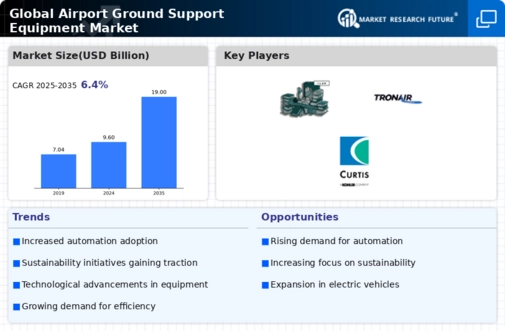Market Analysis
In-depth Analysis of Airport Ground Support Equipment Market Industry Landscape
The airport ground support equipment (GSE) market is influenced by various market factors that collectively shape its dynamics, ranging from the expansion of air travel to regulatory requirements and technological advancements. One key factor is the robust growth in global air traffic. The increasing number of air passengers worldwide drives the demand for efficient ground handling operations at airports, thereby fostering the need for advanced GSE. As airports experience heightened aircraft movements and higher passenger volumes, the market factors are influenced by the imperative to enhance operational efficiency and maintain smooth airport logistics.
Buckle up for smoother takeoffs and landings! The aircraft ground support equipment market is about to hit the runway with a 6.4% CAGR, reaching a projected USD 9.6 billion by 2030. Think everything from baggage loaders to pushback tugs and passenger shuttles – this vital behind-the-scenes crew keeps planes prepped, passengers pampered, and cargo on track. So next time you soar through the skies, remember the silent heroes of the tarmac ensuring your journey is safe, efficient, and maybe even a little more comfortable. Safety and environmental regulations constitute significant market factors in the airport GSE sector. The aviation industry is subject to stringent safety standards and environmental mandates, requiring airports and ground handling service providers to adhere to specific guidelines. Compliance with these regulations influences the market dynamics, prompting manufacturers to develop GSE that meets safety and emission standards. The demand for GSE that aligns with environmental sustainability goals, incorporating features like lower emissions and noise reduction, is a notable factor shaping the market.
Technological advancements play a pivotal role in shaping the market factors of the airport GSE market. The continual evolution of technologies, including electric propulsion, automation, telematics, and connectivity, introduces new capabilities and efficiencies to ground handling operations. The market factors are influenced by the development of smart GSE equipped with sensors, data analytics, and real-time monitoring capabilities, contributing to improved maintenance practices and operational effectiveness. The pace of technological innovation drives market competitiveness and shapes procurement decisions by airports seeking cutting-edge solutions.
Economic factors, such as fuel prices and overall economic conditions, significantly impact the airport GSE market. Fluctuations in fuel prices have a direct effect on operational costs for airlines and airports. The market factors are influenced by the demand for fuel-efficient GSE solutions that contribute to cost savings. Additionally, the overall economic climate and conditions influence the budgetary decisions of airports, affecting their capacity to invest in new and advanced GSE. Economic stability and growth contribute to increased capital expenditure, fostering demand for innovative GSE solutions.
Airports' infrastructural development projects are critical market factors in the airport GSE sector. As airports undergo expansions, renovations, and capacity enhancements to accommodate growing air traffic, the demand for GSE that integrates seamlessly with modern airport infrastructure becomes imperative. Market factors are shaped by the need for GSE solutions that can support increased aircraft movements and passenger loads, contributing to the efficiency of ground handling operations during airport infrastructure development projects.
The trend towards outsourcing and privatization of ground handling services is a significant market factor influencing the demand for airport GSE. Many airports globally opt to outsource ground handling operations to specialized service providers, creating a demand for efficient and adaptable GSE. Market factors are shaped by the need for GSE solutions that can cater to diverse aircraft types and handle various ground handling functions efficiently, aligning with the requirements of outsourced services and privatized ground handling operations.
Regulatory initiatives related to safety and emissions contribute to market factors influencing the airport GSE sector. Governments and aviation authorities implement regulations to ensure safe and environmentally responsible ground handling practices. Compliance with these regulations becomes a market factor that guides the development and adoption of GSE solutions. Manufacturers focusing on innovative and compliant GSE solutions gain a competitive edge in a market where adherence to regulatory standards is paramount.
The global focus on sustainability and environmental responsibility is a growing market factor in the airport GSE sector. The aviation industry is increasingly recognizing the importance of reducing its carbon footprint and adopting greener practices. Market factors are influenced by the demand for GSE solutions that prioritize environmental sustainability, including electric and hybrid options, as airports strive to align with global efforts to mitigate the environmental impact of air travel.
Global events, such as the COVID-19 pandemic, can significantly impact market factors in the airport GSE sector. The pandemic underscored the importance of health and hygiene considerations in airport operations. Market factors were influenced by the need for GSE solutions that prioritize passenger and employee safety, introducing features such as touchless controls and antimicrobial surfaces to enhance health-conscious ground handling practices.






Leave a Comment